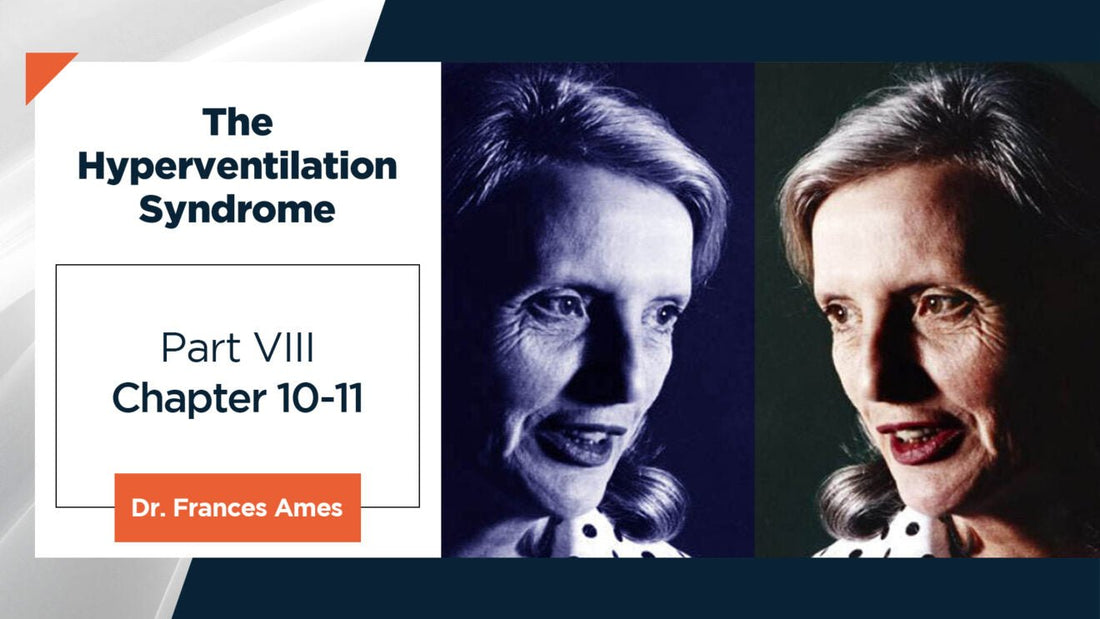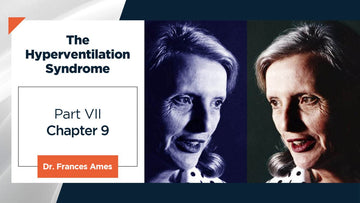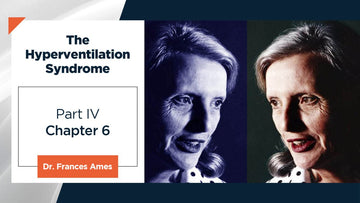
The Hyperventilation Syndrome - Dr. Frances Ames Part VIII
CHAPTER 10 - REFERENCES
- Baker, D.M. (1934): Sighing respiration as a symptom, Lancet I (174)
- Barker, L.F. and Sprunt, T.P. (1922): A spontaneous attack of tetany during a paroxysm of hyperpnoea in a psychoneurotic patient convalescent from epidemic encephalitis, Endocrinology 6 (1)
- Barnes, C. G., and Greaves, R.I.N. (1936): The role of calcium in spontaneous overbreathing tetany, Quart. J. med. 5 (341)
- Bazett, H.C., and Haldane, J.B.S. (1921): Some effects of hot baths on man, J. Physiol. 55 (4)
- Binet and Sollier (1895): Arch.Phys.norm.path. 7 (719). Cited by Bolton, B., Carmichael, E.A. and Sturup, G. in J. Physiol. (1936), 86 (83)
- Bolton, B., Carmichael, E.A . and Sturup, G. (1936): Vasoconstriction following deep inspiration, J . Physiol. 86 (83)
- Boothby, W. M., Hinshaw, H.C . (1941): Some aspects of hyperventilation with special reference to aviation medicine, Proc. Mayo Clin. 16 (211)
- Brazier, M.A.B., Finesinger, J.E., and Schwab, R.S . (1944): Characteristics of the normal electroencephalogram. 111. The effect of varying blood sugar levels on the occipital cortical potentials in adults during hyperventilation. J. Clin. Invest. 23 (319)
- Brown, W. Langdon, and Milton, R. (1930): Physiological principles in treatment. Chap . 7 Cited by Harrison, G.A. (1943): Chemical methods in clinical medicine, p . 51. London. Churchill.
- Cannon, W. B. (1920): Bodily Changes in Pain, Hunger, Fear, and Rage. An Account of Recent Researches into the Function of Emotional Excitement, p . 202. New York, D. Appleton, and company.
- Carryer, H.M. (1943): Syndrome of Hyperventilation with Tetany, report of a case. Proc. Mayo Clin. 18 ( 522)
- Carryer, H, M. (1947): The Hyperventilation syndrome Med. Clin. of North America, 31 (845).
- Christensen, B. Chr. (1946): Studies on Hyperventilation. 1. Electrocardiographic changes in normal man during voluntary hyperventilation. J. Clin. Invest. 25 (880)
- Christie, R. V. (1935): Some types of respiration in the neuroses. Stuart. J. med. 4 (427)
- Clarke, R.S.J. (1952): The effect of voluntary overbreathing on the blood flow through the human forearm. J. Physiol. 118 (537)
- Collip, J.B., and Backus, P.L. (1920): The effect of prolonged hyperpnoea on the carbon dioxide combining power of the plasma, the carbon dioxide tension of the alveolar air, and the excretion of acid and basic phosphate and ammonia by the kidney. Amer. J.Physiol. 51 (568)
- Cumings, J.N., and Carmichael, E.A. (1957): The cerebrospinal fluid in spontaneous overbreathing tetany. Lancet 1 (201).
- Darrow, C.W. and Pathman, J.H. (1943-44): Relation of heart rate to slow waves in the encephalogram during over-ventilation. Amer. J. Physiol. 140 (583).
- Darwin, C. (1943): The expression of the emotions in man and animals. 2nd impression Thinker's Library, p . 151. London. C.A. Watts
- Davis, H. and Wallace, W. McL. (1942): Factors affecting changes produced in electroencephalography by standardized hyperventilation. Arch. Neurol. Psychiat. 47 (606)
- Dibden, W.A. (1949): The Hyperventilation Syndrome. Med. J. Australia 2 (409). 97
- Duzer, J. and Hensch, W. Adrenalintetanie. Jahrb. Kinderheilk. 114, 142 (1926) cited by Harvey and Lilienthal (1942J Bull. John Hopkins Hospital, 71, (163).
- Eichna, L. W. and Wilkins, R. W. (1941): Blood flow to the forearm and calf. Bull. John Hopkins Hospital, 68 (450)
- Engel, G.L., Ferris, E.B. and Logan, M. (1947): Hyperventilation: Analysis of clinical symptomatology. Ann. intern.Med. 27 (683)
- Fowweather, F. S., Davidson, C.L. and Ellis, L. (1940): Spontaneous Hyperventilation tetany. Brit. med. J. 2 (373).
- Fraser, R., and Sargant, W. (1938): Hyperventilation attacks - A manifestation in hysteria. Brit. med. J. 1 (378)
- Friedman, M. (1945): Studies concerning the etiology and pathogenesis of neurocirculatory asthenia. Amer. Heart J. 30 (325, 478)
- Gibbs, E .L., Gibbs, F.A., Lennox, W.G. and Nims, L.F. (1942): Regulation of cerebral carbon dioxide. Arch. Neurol. Psychiat. 47 (879)
- Gibbs, E.L., Lennox, W.G. and Gibbs, F.A. (1940): Variations in the carbon dioxide content of the blood in epilepsy. Arch.Neurol. Psychiat. 43 (223)
- Gilliat, R.W. (1948): Vasoconstriction in the finger after deep inspiration. J. Physiol. 107 (76)
- Gilliat, R.W. (1948): Inspiratory vasoconstriction in patients after spinal injuries. J. Physiol. 107 (67)
- Gliebe, P.A. and Auerback, A. (1944): Sighing and other forms of hyperventilation simulating organic disease. J. Nervous and Mental Disease, 99 (600)
- Goetz, R.H. (1933): Klin. Wochensch. 44 (1717) cited by Goetz (1942) in Clin.Proc. 1 (190)
- Goetz, R.H. (1935): Pflueg. Arh. 235 (271)
- Goetz, R.H. (1942): Smoking and Thrombo- angiitis obliterans. Clin. Proc. 1 (190)
- Goetz, R.H. (1943): The rate and control of the blood flow through the skin of the upper extremities. S. Afr. med. Sci. 8 (65)
- Goetz, R.H. (1948): Clinical Plethysmography. S. Afr. med. J. 22 (391, 422)
- Goetz, R.H. and Ames, F. (1949): Reflex Vasodilatation by body heating in diagnosis of peripheral vascular disorders. Arch. intern. Med. 84 (396).
- Goetz, R.H. (1950): Effect of changes in posture on peripheral circulation, with special reference to skin temperature readings and the plethysmogram. Circulation 1 (56)
- Goldman, A. (1922): Clinical tetany by forced respiration. J . Amer. med. Ass. 78 (2) (1193)
- Grant, S.B. and Goldman, A. (1920): A study of forced respiration: Experimental production of tetany. Amer. J. Physio. 52 (209)
- Guttman, E. and Jones, U. (1940): Hyperventilation and the Effort Syndrome. Brit. med. J. (2) (736)
- Haldane, J.S and Poulton, E. P. (1908): The effects of want of oxygen on respiration. J. Physiol. 37 (390)
- Harvey, A.M. and Lilienthal, J .L. (1942): Observations on the nature of tetany. Bull. John Hopkins Hospital, 71 (163)
- Henderson, Y. (1909): Acapnia and Shock-4. Fatal apnoea after excessive respiration. Amer. J. Physiol. 25 (310)
- Herxheimer, H. (1946): Hyperventilation asthma, Lancet. 350 (83)
- Hill, L., and Flack, M. (1910): The influence of oxygen on muscular work. J. Physiol. 40 (347)
- Hill, D., and Parr, G. (1950): Electroencephalography. A symposium. on its varied aspects. First edition. p. 145-152. London. MacDonald
- Kerr, W.J., Dalton, J.A. and Gliebe, P.A. (1937): Some physical phenomena associated with the anxiety states and their relation to Hyperventilation. Ann. Int. Med. 11 (961)
- Kerr, W.J., Gliebe, P.A., Soley, M.H. and Shock, N.W. (1939): Treatment of the anxiety states; with special attention to certain physiologic manifestations. J. Amer. med. Ass. 113 (637)
- Kety, S.S., and Schmidt, C.F. (1946): The effects of active and passive hyperventilation on cerebral blood flow, cerebral oxygen consumption, cardiac output and blood pressure of normal young men. J. Clin. Invest. 25 (107)
- Kugelberg, E. (1946): Neurologic mechanism for certain phenomena in tetany. Arch. Neurol. Psychiat. 56 (507)
- Kugelberg, E. (1948): Activation of human nerves by ischemia. Arch. Neurol. Psychiat. 60 (140). Activation of human nerves by hyperventilation and hypocalcemia. Arch. Neurol. Psychiat.60 (153)
- Lewis, T., Bickering, G.W. and Rothschild, P. (1933): Centripetal Paralysis arising out of arrested blood flow to the limb. Heart 16 (1)
- Lewis, T. (1942): Trousseau's phenomenon in tetany. Clin. Sci. 4 (361)
- Maytum, C.K., and Willius, F.A. ( 1934): Abnormal respiration of functional origin. Proc. Mayo Clin. 9 (308), cited by Silverberg, M.D. (1942): Med. J. Australia 2. (38)
- McCance, R.A. (1932): Spontaneous overbreathing tetany. Quart. J. Med. 1 (247)
- McCance, R.A. and Watchorn, E. (1937): Overbreathing tetany: changes in the calcium of serum, serum ultrafiltrates, and cerebrospinal fluid. Lancet 1 (200)
- McKell, T.E. and Sullivan, A.J. (1947): The Hyperventilation syndrome in gastroenterology. Gastroenterology. 9 (6)
- Mills, J.N. (1946): Hyperpnoea induced by forced breathing. J. Physiol. 105 (95)
- Mulinos, M.D. and Shulman, I. (1939): Vasoconstriction in the hand from a deep inspiration. Amer. J. Physiol. 125 (310)
- O'Donovan, D.K. (1943): The hyperventilation syndrome. Irish J. Med. Sci. 205 (519, 564)
- Peters (1939): Pflueg. Arch. 241 (201) cited by Goetz (1942): Olin. Proc. 1 (190)
- Rice, R.L. (1950): Symptom patterns of hyperventilation. Amer. J . Med. 8 (691)
- Rosett, J. (1924): The experimental production of rigidity, of abnormal involuntary movements and of abnormal states of consciousness. Brain 47. (293)
- Rouzzak, N.J. (1951): Hysterical abdominal proptosis. Gastroenterology. 17 (133)
- Russel, R. (1952)? Lancet, March 29 (664)
- Scherf, D. and Schlachman, M. (1947): The electrocardiographic changes caused by hyperventilation. Amer. J. med. Sci. 213 (342)
- Schultzer, P. and Lebel, H. (1939): Spontaneous Hyperventilation tetany. Acta. med.Scand.101(303). 101
- Silverberg, M.D. (1942): Sighing Dyspnoea and the Hyperventilation syndrome. Med.J.Australia 2 (38)
- Soley, M.H. and Shock, N.W. (1938): The etiology of effort syndrome. Amer. J. med. Sci. 196 (840)
- Stead, E.A. and Warren, J.V. (1943): The role of hyperventilation in the production, diagnosis, and treatment of certain anxiety symptoms. Amer. J. med. Sci. 206 (183)
- Thompson, W. P. (1943): The electrocardiogram in the hyperventilation syndrome. Amer.Heart J. 25 (372)
- Uhlenbruck (1924): Z. Biol. 80 (5). Cited by Bolton et al. J. Physiol. 86 (83)
- Vernon, H.M. (1909): The production of prolonged apnoea in man. J. Physiol. 38 (18)
- Vincent, S. and Thompson, J.H. (1928): The effect of hyper-respiration on the blood pressure in man. J. Physiol. 66 (307)
- Westdahl, P.R. (1951): Hysterical abdominal distension simulating acute intestinal obstruction California. Med. May (377)
- White, P.D. and Hahn, R.G. (1929): The symptom of sighing in cardiovascular diagnosis - with spirographic observations. Amer. J. med. Sci . 177 (179)
- Wood, P. (1941): Da Costa's syndrome (or Effort Syndrome). Brit. med. J . 1 (767, 805, 845)
- Wingfield, A. (1941): Hyperventilation tetany in tropical climates. Brit. med. J. 1 (929)
CHAPTER 11 - ACKNOWLEDGMENTS
It is with pleasure that I record my gratitude to a great many people. Professor Forman supplied the inspiration for this piece of work. Dr. S. Berman gave me a great deal of sound advice, especially about the neurological aspect. He supplied the electroencephalographic record illustrating delta activity.
Professor R. Goetz made available to me all the facilities of his laboratory and taught me a great deal about the technique of research and of peripheral vascular work generally.
Dr. A. Dull administered the gas mixtures and was always a willing and reliable experimental subject.
To the many colleagues who so patiently and good-humouredly overbreathed for me got my heartfelt thanks. Among these, I must specifically thank Dr. A. Swanepoel, Dr. R. Mibashon, Dr. M. Lange, and Miss Walton.
Dr. Werbeloff is responsible for the x-rays.
Mrs. Goosen did the photography.
Dr. Budtz-Olsen helped a great deal in the final compiling of the thesis.
The Staff Research Fund made me a grant for which I am very grateful.
Finally, I am greatly indebted to my husband, who cooperated with me to make the communication of ideas in this thesis as clear as possible.
Previous Chapter






